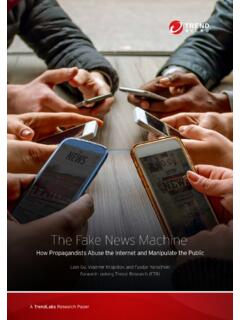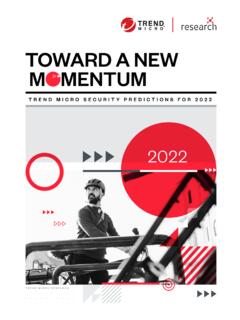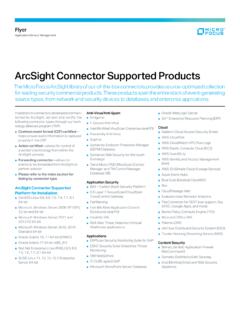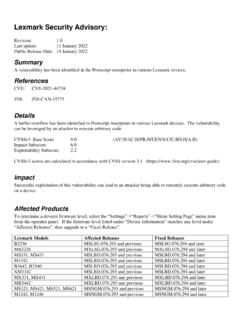Transcription of ISO/SAE 21434: Setting the Standard for ... - Trend Micro
1 ISO/SAE 21434 Vit SemberaSetting the Standard for Connected Cars CybersecurityTREND Micro LEGAL DISCLAIMERThe information provided herein is for general information and educational purposes only. It is not intended and should not be construed to constitute legal advice. The information contained herein may not be applicable to all situations and may not reflect the most current situation. Nothing contained herein should be relied on or acted upon without the benefit of legal advice based on the particular facts and circumstances presented and nothing herein should be construed otherwise. Trend Micro reserves the right to modify the contents of this document at any time without prior of any material into other languages are intended solely as a convenience. Translation accuracy is not guaranteed nor implied. If any questions arise related to the accuracy of a translation, please refer to the original language official version of the document.
2 Any discrepancies or differences created in the translation are not binding and have no legal effect for compliance or enforcement Trend Micro uses reasonable efforts to include accurate and up-to-date information herein, Trend Micro makes no warranties or representations of any kind as to its accuracy, currency, or completeness. You agree that access to and use of and reliance on this document and the content thereof is at your own risk. Trend Micro disclaims all warranties of any kind, express or implied. Neither Trend Micro nor any party involved in creating, producing, or delivering this document shall be liable for any consequence, loss, or damage, including direct, indirect, special, consequential, loss of business profits, or special damages, whatsoever arising out of access to, use of, or inability to use, or in connection with the use of this document, or any errors or omissions in the content thereof.
3 Use of this information constitutes acceptance for use in an as is Policy and Upcoming Recommendations9 Introduction4 ISO/SAE 21434: A Sectional Overview12 Published by Trend Micro ResearchWritten by Vit SemberaStock image used under license from Micro Solutions37 Conclusion43 Executive SummaryToday s cars are Setting new standards in terms of use and expectations for both drivers and passengers. Cars now offer a wide range of convenience, information, communication, and entertainment options that include internet access, app-based remote monitoring and management, advanced driver-assistance systems, and even autonomous driving These changes aren t just taking place under the hood, where electric motors are increasingly replacing combustion engines. The rapid increase and dependence on software used in vehicles in recent years2 have also changed the way people use their addition, new vehicle usage trends such as car-sharing platforms and mobility-as-a-service remote fleet management are on the rise.
4 Unfortunately, these developments put a significant amount of stress on the automotive industry as development and production cycles are shortened and the adoption rate of new technologies exponentially As a result, cybersecurity measures have trailed behind, and some issues remain Cybersecurity incidents lead to significant losses, not only costing the business and industry financial and reputational harm but also their customers safety in the long shown in several publications, the number of attack vectors in connected cars and the automotive industry is significant. As more cybersecurity gaps are left open and unresolved, a sizable number of openings are left vulnerable for abuse. With the increasing call for the introduction and enforcement of cybersecurity standards for the industry, the combined ISO and SAE task force drafted and introduced ISO/SAE 21434, a set of guidelines for securing high-level processes in connected research paper summarizes the policy and our recommendations for the new cybersecurity Standard for the automotive industry, established in the context of currently adopted technologies, security challenges, and known | ISO/SAE 21434: Setting the Standard for Connected Cars CybersecurityIntroductionEnhanced connectivity is central to innovation.
5 By connecting cars to networks and the backend, the industry has been pivoting to the commercialization of constantly connected vehicles. Autonomous driving, fleet management, app-based tracking or control capabilities, or real-time telematics data collection are just some representative examples. However, while they bring new opportunities and capabilities, the rapid evolution of these systems also presents new complexities and security Cybersecurity Perspective on the Evolution of TechnologyOne of these complexities involves the number of internal subsystems found inside a vehicle s electronic system called electronic control units (ECUs). The modern ECU is basically a computer collecting data from directly attached sensors or indirectly attached buttons, switches, and other bus nodes, processing them and controlling directly attached actuators or indirectly attached bus nodes like LED indicators. ECUs are connected together via different types of internal bus protocols and share important vehicle state values in real time.
6 A critical part of each ECU is software and corresponding data enabling the flawless functioning of the vehicle subsystem ECU is dedicated to but also ensuring the orchestrated cooperation of all ECUs together so the vehicle reacts properly on all internal and external inputs. The number of ECUs in vehicles have increased over time, with some cars having more than 100 accompanying the enhanced connectivity of these modern cars to facilitate data transfer between bus nodes include the controller area network flexible data-rate (CAN/CAN FD),6 LIN, MOST, Ethernet, and FlexRay. These protocols were designed to be resistant against failures in harsh vehicle environments but none of them have integrated security features such as data encryption or sender authentication. CAN is especially known for its vulnerability to injection attacks. Modern cars possess a gateway ECU interconnecting and separating internal vehicle busses, but it can be assumed that this component was not designed as a security device that acts as a | ISO/SAE 21434: Setting the Standard for Connected Cars CybersecurityImproved traffic and rider safety is another common selling and talking point for the car industry.
7 Passive safety features, such as seatbelts, airbags, and crumple points, have been improved to meet raised industry standards and consumer demand, while active safety features that can prevent unnecessary collisions are currently found in modern cars. According to the World Health Organization (WHO), a significant portion of fatal traffic incidents involve human errors and other factors, such as failure to use a seatbelt, driving while under the influence of alcohol or psychoactive drugs, speeding, and the presence of distractions on the Plans are underway to equip upcoming vehicle models with advanced driver assistance systems (ADAS) with semi- or fully-autonomous driving systems, as well as communication systems between vehicles (V2V) or with other traffic infrastructure (V2I)9 to avoid accidents or reduce their retrospect, a new era of connected cars seemingly began when these vehicles gained the ability to connect to remote backend systems.
8 Newer cars in the European Union (EU) and the Russian Federation are connected almost all the time through cellular networks, in compliance with eCall11 and ERA-Global Navigation Satellite System (ERA-GLONASS),12 transforming cars into internet of things (IoT) devices. And much like IoT devices, a similar set of cybersecurity challenges have cropped up as these cars go online. For instance, previous publications and research have shown that it s possible for an attacker to remotely control a car, similar to the way cybercriminals can take over connected devices in offices and than ever, stakeholder safety addressing induced risks via cybersecurity requirements have become essential. The draft of ISO/SAE 21434, which is intendedto establish cybersecurity engineering baselines for connected cars, is based on the SAE J3061_201601 Cybersecurity Guidebook for Cyber-Physical Vehicle Systems best practices This addresses the cybersecurity perspective in the engineering of electrical and electronic (E/E) systems in road vehicles.
9 By ensuring appropriate consideration of cybersecurity, the guide aims to enable the engineering of E/E systems to keep up with evolving technologies and attack methods that may be discovered. Considering the current or upcoming autonomous driving subsystems embedded in cars on the road today, the risks of cyberattacks on E/E subsystems are Security Challenges of Current Vehicle TechnologiesSystems have a significant number of ports exposed online, all of which can potentially be abused for cybercriminal entry. A thoroughly implemented and security-first design for hardware and software, which makes adversarial attacks difficult to deploy, is crucial. Currently, however, a systematic approach for security is uncommon in the automotive attacker who can take over the execution of any ECU can move laterally to any target or point of interest. For instance, an attacker can execute a relatively simple and harmless in-vehicle infotainment 6 | ISO/SAE 21434: Setting the Standard for Connected Cars Cybersecurity(IVI) ransom lock.
10 However, the danger and impact for the car users can escalate as the attacker can easily move to the other components of the vehicle: disabling and holding the engine start function for ransom; continuing with denial of service (DoS) attacks on drivetrain ECUs and forcing them to fail; or initiating hazardous actions such as controlling the brakes, steering, engine, and/or airbag actuators. With careful planning and timing, controlling a connected car to induce a deadly crash is conceivable and difficult to prove in official post-crash car companies would certainly like to implement stronger security procedures and mechanisms in connected cars, the industry s current structure presents challenges in terms of implementation of Typical challenges include: vulnerability mitigation challengesThe automotive industry is a highly tiered supply chain system. Tier 1 vendors are companies that directly supply automotive parts or entire systems to OEMs.











